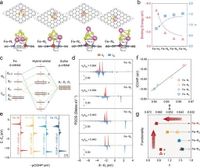Researchers in battery technology are making strides towards more efficient and sustainable energy storage solutions with an innovative approach to sodium-sulfur batteries. The new focus centers on modifying sulfur hosts using coordinatively unsaturated iron single-atom (Fe–Nx) sites. This strategic design aims to enhance the performance of these batteries, which are considered viable for grid-scale energy storage due to their low-cost materials and high potential specific capacity.
Sodium-sulfur (Na||S) batteries rely on sulfur for its high theoretical capacity. However, a major limitation is the poor electrical conductivity of sulfur, resulting in low sulfur utilization and rapid capacity decay during cycling. Additionally, polysulfide species often dissolve in the electrolyte, a phenomenon known as the shuttle effect, leading to losses in battery efficiency.
To overcome these challenges, researchers have proposed the implementation of iron single-atom sites within the sulfur host material. The study outlines the theoretical development of two key descriptors: γ (lNa–S/lFe–N) for geometric structure and φ (eg/t2g) for electronic structure. These descriptors correlate with the unsaturation degree and have been shown to significantly influence the polysulfide behavior in batteries.
A pivotal discovery was the identification of the Fe–N1 site, characterized by the lowest geometric descriptor and highest electronic descriptor values, making it the optimal configuration for enhancing sodium polysulfide interactions. In practical testing, the sodium-sulfur batteries utilizing these modified electrodes demonstrated improved sulfur utilization of 81.4% at a specific current rate of 167.5 mA g–1 and maintained stable cycling performance over 450 cycles.
These findings highlight not just the performance benefits of coordinatively unsaturated iron sites, but also their role in the broader context of sodium-sulfur battery technology. The researchers noted, "Fe–N1 sites provide sufficient space for NaPSs adsorption," effectively improving the kinetics of sodium polysulfide conversion during battery operation.
The practical implications of this approach are significant; sodium-sulfur batteries featuring modified positive electrodes are positioned to deliver not only high capacity but also prolonged operational life. The study confirms that these batteries can reach a sulfur utilization rate of 77.4% at higher specific currents, demonstrating their potential for real-world applications.
Moreover, the design principles established through this research could guide the development of other high-performance single-atom-based catalysts. As the field of energy storage advances, the insights gained from understanding the interactions at the atomic level could catalyze the next wave of improvements in battery technology.
To summarize, this work underscores the importance of innovatively designed materials in optimizing battery performance and reliability. By unlocking the full potential of sodium-sulfur systems through advanced materials science, researchers are paving the way for next-generation energy storage solutions that align with global sustainability goals. The efficiency and stability offered by Fe–N1 sites mark a significant milestone in the quest for enduring and cost-effective energy storage technologies.




